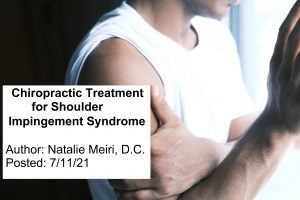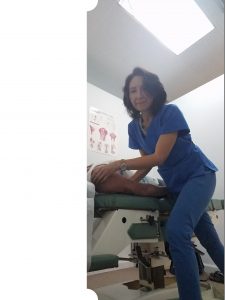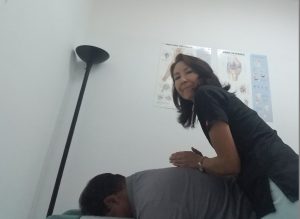
Chiropractic treatment for shoulder impingement syndrome is effective even if you have a bone spur. This was a 55 year old patient who had an insidious (came on slowly, gradually) onset of left shoulder pain. To be HIPAA compliant, I will call her Sharon instead of her real name. Sharon presented to my office unable to lift her left shoulder to do overhead activities without pain. Moreover, Sharon also had sudden shoulder pain with overhead or lifting activity which brought her to see me.
Sharon didn’t have any history of trauma involving her left shoulder. She was a retired teacher and did a lot of housework and gardening at home. Sharon also regularly went to the gym to keep in shape. She felt there was an accumulation of repetitive activities past and present in her life requiring her to perform work/movements in an overhead position of her shoulder. At first, Sharon thought her left shoulder pain was due to her chronic neck pain. She had received chiropractic care for the neck pain on and off for years.

Sharon’s Examination and X-ray
The x-rays taken in my office showed moderate osteoarthritis in her left shoulder, cervical (neck) and thoracic (mid back) spine. This is the “wear and tear” type of arthritis when the bones rub against one another causing pain, stiffness, inflammation, disc degeneration and bone spurs (also known as osteophytes) which can “pinch” surrounding nerve/tissues. For Sharon the most notable finding on x-ray was the bone spur on her shoulder x-ray.
Upon examination, I found positive tests for a shoulder impingement syndrome diagnosis. Sharon’s shoulder impingement was mostly due to the bone spur visualized on her shoulder x-ray. The bone spur was due to the osteoarthritis (degenerative wear and tear arthritis) in her shoulder. I would order an MRI of her left shoulder if there was no improvement after 12 visits.
What is shoulder impingement syndrome?
A shoulder impingement syndrome is defined as a compromise of the space between the coracoacromial arch (portion of top outer edge of shoulder blade) and the proximal (situated nearer the center of the body) humerus (upper arm bone). So several structures may get impinged (pinched): The biceps tendon, superior labrum (cartilage in shoulder joint), supraspinatus (1 of the rotator cuff muscles) tendon, and the subacromial bursa (a fluid-filled sac for countering friction at a joint ) are all vulnerable to being impinged.
Causes for shoulder impingement include both structural and functional reasons:
Structural reasons:
-variant acromial types that are hooked or lengthened (top portion of shoulder blade developed/grew abnormal)
-degenerative (wear and tear arthritic) changes on the undersurface of the acromion
-an inflammatory process in the subacromial space (which could be due to i.e. bursitis, rotator cuff tear, or/and all of the above)
Functional reasons:
-abnormal position of your spine or scapula (ie. thoracic kyphosis)
-tightness of your shoulder capsule (membrane around shoulder joint),
-decrease in the space between the coracoaromial arch and proximal humerus due to past injuries
-abnormal motion due to nerve related problems (i.e. nerve palsy)

Chiropractic Treatment for Shoulder Impingement Syndrome
Starting at 2 times a week and then 1 time a week, Sharon’s treatments included chiropractic adjustments/manipulation to her left shoulder, and associated regions. Associated regions adjusted were her cervical (neck) and thoracic (mid back) spine. Additionally, soft tissue therapy (myofascial release, pressure point and various post isometric relaxation procedures) and modalities (cold/heat therapy and electric muscle stimulation) were administered as needed. Finally, therapeutic exercises to continue treatment at home were given.
Firstly, the goal was to get her out of pain. Secondly, restore normal range of motion to her shoulder. Thirdly, to strengthen the rotator cuff and scapulothoracic (mid back where her left shoulder is attached) musculature. As Sharon made progress, I also adjusted her low back to optimize her athletic performance at the gym and daily activities. The long-range goal was to stabilize her shoulder with a progressive rehabilitation program and modification of sport or/and occupational/daily lifestyle activities.
Sharon felt better from the first treatment. After a few months of treatment, she got her full range of motion back in her shoulder. Furthermore, Sharon was able to gradually introduce overhead activities without pain. Lastly, she no longer experienced pain with lifting.
Chiropractic is for people who want to move and perform better in life. Chiropractic is for patients who don’t want drugs or surgery. Ultimately, it’s not just for pain relief. It’s for those who want a better quality of life.
Meiri Chiropractic serving West Palm Beach, Jupiter, North Palm Beach, and Palm Beach Gardens offers chiropractic treatment for shoulder impingement syndrome. Call 561-253-8984 today to schedule an appointment.